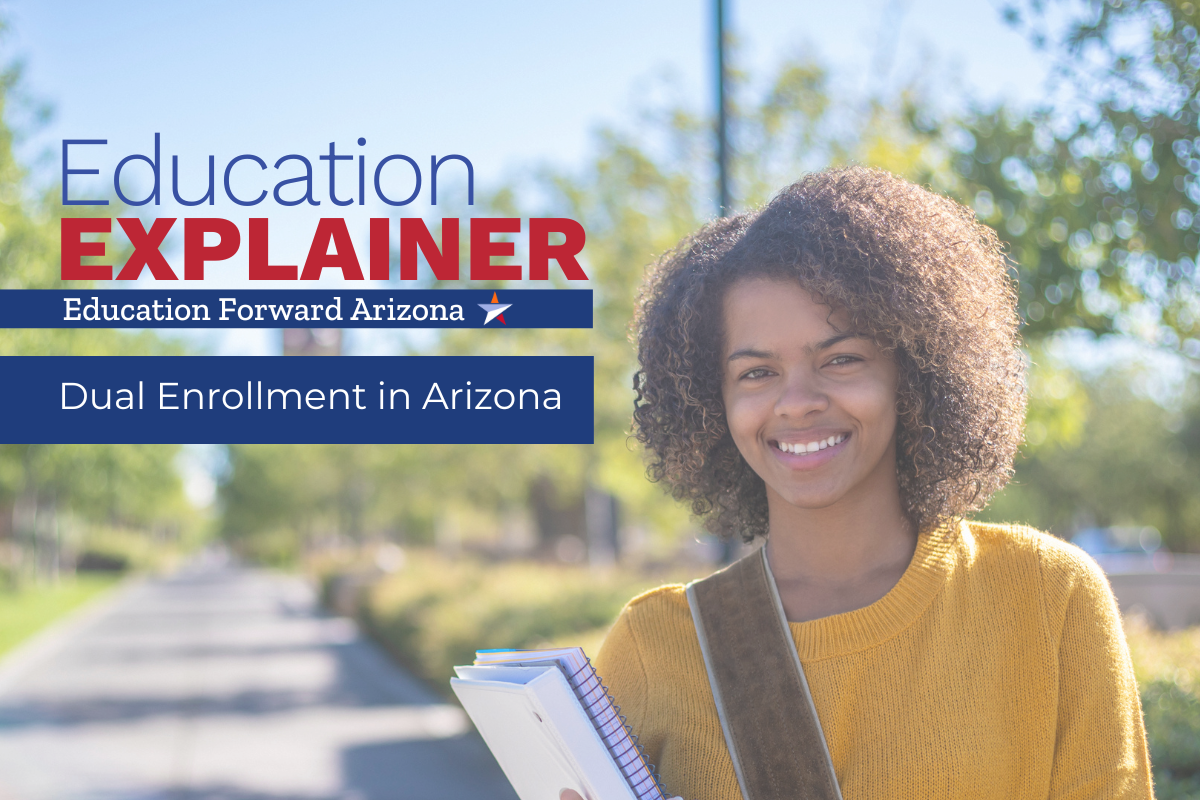
Education Explainer: Dual Enrollment
Research has documented that dual enrollment courses for high school students prepare students for success at a community college, university or vocational program. Dual enrollment is a key strategy in helping Arizona reach its Achieve60AZ goal of getting 60% of adults in the state to obtain postsecondary education attainment by 2030.
This Education Explainer will cover what dual enrollment is, the benefits it provides, and what can be done to increase dual enrollment access for all Arizona students.
What is dual enrollment?
Dual enrollment allows students to take a college-level course where they earn college credits and fulfill a course requirement for high school graduation.
Most dual enrollment courses are taught at high schools, but some are offered online. English, career and technical education, and math are the most common types of dual enrollment courses taken by students in Arizona.
What are the benefits of dual enrollment?
Dual enrollment can be a powerful way to increase postsecondary readiness, participation, and attainment.
- Preparedness. Dual enrollment helps students prepare for college by doing college-level coursework. It allows students to learn through experience how they can be successful in a postsecondary setting in the future.
- Postsecondary Participation. Arizona students who participate in dual enrollment are more than two times as likely to attend college when compared to their peers who do not participate in dual enrollment, according to a recent research brief from the Helios Education Foundation entitled, “Dual Enrollment in Arizona High Schools.” Dual enrollment has shown to be particularly beneficial for increasing the number of male, Hispanic/Latino, low-income, and special education students who advance to attend college.
- Persistence. Arizona students who participated in dual enrollment were more likely to persist in their postsecondary studies from year one to year two.
Additionally, some dual enrollment programs help students earn college credits more affordably.
Why is dual enrollment important?
Increasing equitable access to dual and concurrent enrollment was identified by education and community stakeholders as one of the top 10 priorities to help Arizona reach its Achieve60AZ attainment goal.
By increasing dual enrollment access, Arizona can increase the number of students who are prepared and ready for education after high school. Increasing the state’s attainment percentage with a more educated workforce adds billions of dollars to our economy.
Where does Arizona stand today with dual enrollment?
Arizona is falling behind the national average in dual enrollment.
The most recent national data shows that about one in three students took at least one dual enrollment course before completing high school, while just one in four Arizona high school graduates (24%) took at least one dual enrollment course, according to the Helios Education Foundation.
Additionally, Black, Hispanic/Latino, and low-income students are also participating in dual enrollment at half the rate or less of their White and more affluent peers.
What are the barriers to dual enrollment?
In 2020, students at about half of Arizona high schools did not participate in dual enrollment. Common barriers for dual enrollment participation include:
- Access. Students can only take dual enrollment courses if there are certified teachers available and schools are able to offer these classes.
- Affordability. While some schools have partnered with colleges to cover or reduce the cost of dual enrollment courses for students, others require students and their families to cover tuition and fees.
- Student eligibility. In Arizona, there is no standardized way to determine eligibility for dual enrollment. Some courses require students to have taken college readiness exams—such as the PSAT, SAT, or ACT—or state accountability assessments, blocking access to students who cannot afford or have not taken these assessments.
What is being done to increase dual enrollment in Arizona?
The Arizona Student Opportunity Collaborative (AzSOC) is an innovative nonprofit organization working to expand dual enrollment access at low-cost or no-cost to students by offering online courses and curricula to schools.
Additionally, the Arizona Teachers Academy program is helping improve access by offering scholarships to support dual enrollment training for high school teachers through partnerships with Northern Arizona University and Arizona State University.
Senate Bill 1717 is also under consideration by the state legislature this year to help provide more students with access to dual enrollment opportunities.
How would SB 1717 increase dual enrollment access?
As it’s currently written, SB 1717 would help increase dual enrollment access for students statewide by incentivizing more schools and teachers to offer dual enrollment courses and by providing financial assistance for dual enrollment, especially to low-income students.
What exactly would SB 1717 do?
SB 1717 would create a Dual Enrollment Incentive Program within the Department of Education. It would provide incentive bonuses to school districts, charter schools, and teachers for students who obtain a passing grade in a qualifying dual enrollment course.
It would also provide a one-time bonus to teachers who receive dual enrollment certification and teach at least one dual enrollment course.
This type of incentive model is a common practice across the nation to increase teacher and school interest in dual enrollment. It’s also similar to Arizona’s AP Incentive Fund, which currently provides bonuses to teachers and schools for students who obtain a passing score on a qualifying examination for college credit.
The bill would also provide funds to reimburse students for dual enrollment courses, with priority to students eligible for free or reduced-price lunches. Qualifying students would receive $50 per credit hour, with a maximum of $300 per year for freshmen and sophomores and $600 for juniors and seniors.
What can you do to support dual enrollment access in Arizona?
A phone call, letter or email to your state representatives about dual enrollment can make a difference. You can reach out to your local representatives to ask them to support SB 1717 and other bills that would equitably increase access to dual enrollment.
You can look up your local lawmakers and sign up to be a part of the Education Forward Advocate’s Network to get legislative updates and more from our Action Center.
